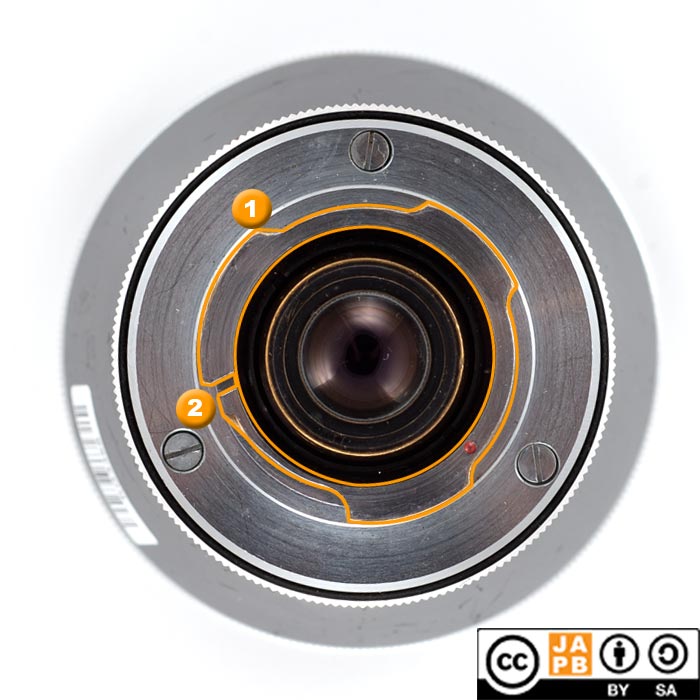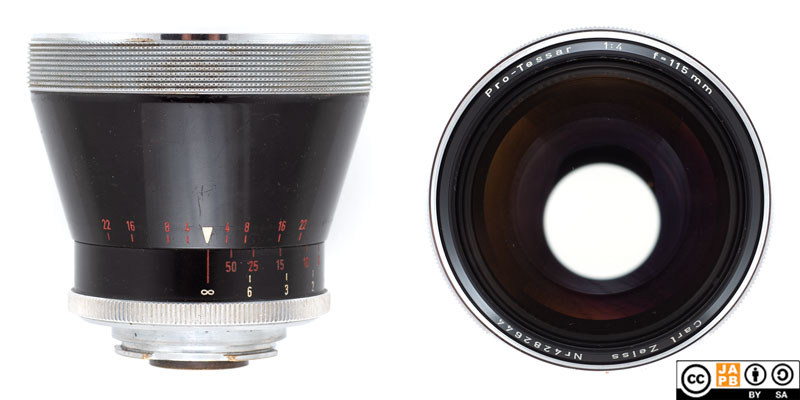Pekka Buttler (Updated 5/2025)
Introduction
This article is about the Contaflex ‘lens mount’.
Technically, the Contaflex is not a lens mount at all (as a big part of Contaflex lenses were permanently attached to the camera body), but is instead the attachment interface of the family of Contaflex ‘set lenses‘.
If you’re unfamiliar with the concept of set lenses, we recommend reading the JAPB article on set lenses before going on.
Note please: The Contaflex mount should not be mistaken for Zeiss Ikon’s largely simultaneous Contarex mount (which was a real lens mount).
Specifications
As noted, Contaflex lenses are not actually lenses, simply the front-ends of lenses. The back-end (including 3 lens elements, the diaphragm, the focusing mechanism etc.) of the Contaflex lenses is permanently attached to the camera body.
The attachment interface between the front-ends and back-ends of Contaflex lenses is a simple bayonet mount that has some cosmetic similarities with the DKL mount, but is significantly smaller and incompatible.

[1] Irregularly-shaped three-pronged bayonet mount;
[2] Locking notch.
Historical context of the Contaflex line
Zeiss Ikon of West Germany had in 1953 introduced its compact Contaflex SLR. The Contaflex (I) differed from the majority of later SLR cameras in that in stead of a focal plane shutter, it used a leaf shutter embedded between the lens elements. The leaf shutter offered a number of distinct advantages over the focal plane shutter (which we recommend you look up in the JAPB glossary). The concept of combining a leaf shutter in an SLR was both novel and promising, however it had the distinct drawback of making interchangeable lenses a difficult proposition.
In 1956 Zeiss Ikon introduced the Contaflex III. This camera utilised the concept of set lenses (lenses which could be built up from compatible parts) to allow for interchangeable lenses. In practice, this meant that the rearmost three elements would be part of the camera body, together with the leaf shutter and focusing mechanism, while you could exchange the front of the lens to gain fundamentally different fields of view. In the case of the Contaflex III, the default (kit) lens amounted to a 50 mm f/2.8 Tessar, but by removing the front-end of that Tessar and replacing that with some of the other Contaflex mount lenses (these were named Pro-Tessar), the result could either be a 35 mm f/4; an 85 mm f/4 or a 115 mm f/4 lens.
From 1956 onward, the Contaflex line diverged: a simpler range of Contaflex cameras (starting with models I and II, continuing with Alpha, Beta and Prima) was targeted at the less ambitious consumer, while for those who wanted the option of different fields of view, there was the advanced range. The early models in the advanced range were the Contaflex III, IV, Rapid, Super, while the later models were the Super (new), Super B, Super BC and Super S. While both the earlier models and the later models used Pro-Tessar lenses, it seems that there was a fundamental redesign of the optics involved, as many later Pro-Tessars had improved mainline specifications (e.g. 35/3.2 instead of 35/4). Several online reports indicate that this change went hand in hand with a minor but crucial modification of the Contaflex mount, making earlier and later front-ends incompatible with other back-ends.

Early Contaflex mount lenses:
• 35 mm f/4 Pro-Tessar
• 50 mm f/2.8 Pro-Tessar (Tessar)
• 85 mm f/4 Pro-Tessar
• 115 mm f/4 Pro-Tessar
Late Contaflex mount lenses:
• 35 mm f/3.2 Pro-Tessar
• 50 mm f/2.8 Pro-Tessar (Tessar)
• 85 mm f/3.2 Pro-Tessar
• 115 mm f/4 Pro-Tessar
Modularity as a fundamental principle
Besides that functional Contaflex lenses were always a two-part affair, Zeiss Ikon took modularity a bit further by also offering supplementary lenses. Hence, you could attach a macro supplement to the 50/2.8 to allow you to go all the way to 1:1 magnification, or attach a Monocular 8×30 to the 50/2.8 effectively giving a focal length equivalent of 400 mm.
Adapting Contaflex lenses
Sorry to say, but the only meaningful way one can use a Contaflex lens (actually, only the front party of the lens) is when mounted on a same-series Contaflex line body. The main reason for this is that that lens front-end is designed to work together with the optical arrangement, aperture and focusing apparatus that was permanently attached to the body.
If you’ve always considered Gyro Gearloose to be your alter ego, you might disassemble a Contaflex body and try to mount the resulting contraption to your mirrorless camera.